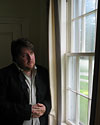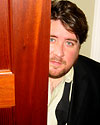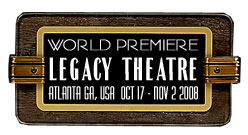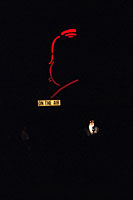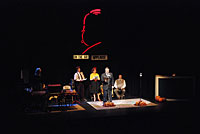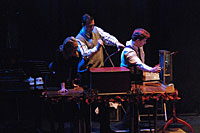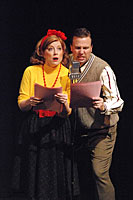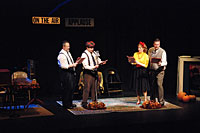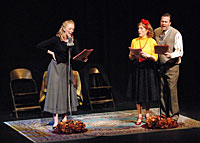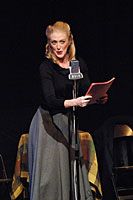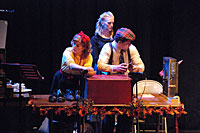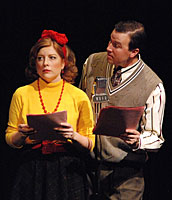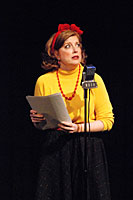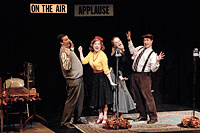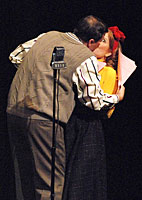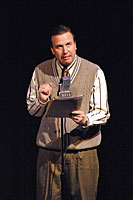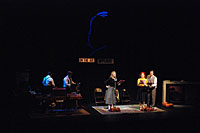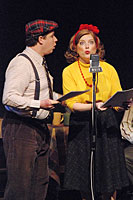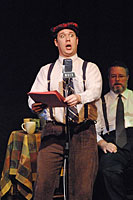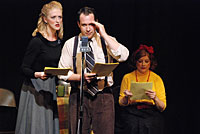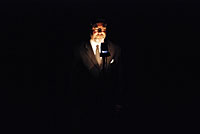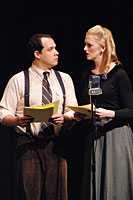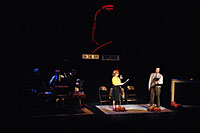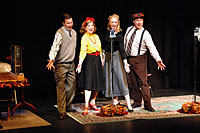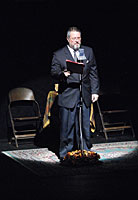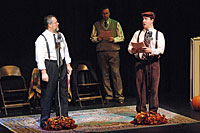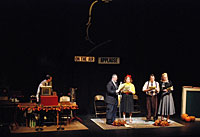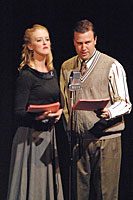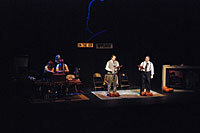
|
"Vintage
Hitchcock: A Live Radio Play" is an evening of adaptations
of three early films directed by Alfred Hitchcock: "The Lodger,"
"Sabotage" and "The 39 Steps." These stories
come to life in the style of a 1940s radio broadcast, with five
actors playing dozens of characters, live sound effects and musical
underscoring.
|
|||||||||||||||||||||||||||||
|
|||||||||||||||||||||||||||||
| The
following introduction appears in the program from the 2008 world
premiere production at Altanta's Legacy Theatre ... Introducing "Vintage" Hitchcock by Sidney Gottlieb Alfred Hitchcock is perhaps the best known and most influential filmmaker in the world, but most people know the Hitchcock of the later period: the director of North by Northwest, Psycho, and The Birds, and the genially macabre host of television's Alfred Hitchcock Presents. But there is also a formidable Hitchcock of a far older vintage: Hitchcock before he came to America; before he met Cary Grant, Ingrid Bergman, and Grace Kelly; and working at full power even before the days of talking pictures. Grabbing on to early Hitchcock, as Joe Landry does, opens up new realms of suspense, mysterious attractions, the dark roots of everyday behavior, and the everyday roots of dark behavior. Joe's selections of vintage Hitchcock are particularly well chosen. Hitchcock often described The Lodger as "the first Hitchcock film." It captures a shadowy and threatening world in which newsboys yell out their stories of the latest murder by the Avenger just as a mysterious stranger shows up at the Bunting household to rent a room. With characteristically sly ambiguity, Hitchcock presents the Lodger as charming and dangerous, equally liable to save the Bunting's daughter from a life of dreary conventionality by romancing her as by killing her, if he is indeed what he seems to be, the Avenger. Typical of Hitchcock, this "if" is never fully removed or resolved, even by the end of the film, which is as tense as it is "happy." This is all in keeping with what he often defined as his main goal in making films: "to put the audience through it" -- "it" being presumably some kind of artful emotional wringer. The 39 Steps dispatches with Victorian melodrama and eerie gaslights but reveals a world of equally chilling horrors. Here Hitchcock skillfully addresses two great perils: living in a world of life and death political intrigue and attempting to forge a trusting and mutually satisfying intimate relationship. Richard Hannay must save England from its enemies, both foreign and home-grown, and also somehow negotiate a growing but precarious romance with Pamela, a woman who of course instantly dislikes and distrusts him. As it turns out, it takes a couple to save England, and it takes the dangers encountered while forced to travel together on the road to forge a couple. Many have tried but few have succeeded in doing what Hitchcock accomplishes so smoothly in The 39 Steps: infusing a story of the world on the brink with the wit, romance, and playful seriousness of a screwball comedy. The Lady Vanishes continues in the path of The 39 Steps, and nicely complements it by expanding on and strengthening the women's roles. In a literal sense, the lady who vanishes is Miss Froy, who is far more than the dotty lady on holiday she seems to be. Making her reappear and return home safely is one of the major plotlines of the film, and again, as in The 39 Steps, the strange business of national security requires the efforts of a couple. But in a figurative sense, Iris, the young woman of the developing couple, is also a lady who vanishes: by engaging in a mystery with political consequences as well as a romance with personal consequences, she changes from a snooty, self-absorbed lady wrapped in a young woman's body to a vibrant, likeable, and resourceful citizen and lover. Iris is a much more fully developed character than Pamela in The 39 Steps, and that's part of what makes The Lady Vanishes so memorable as a Hitchcockian romance. There is, to be sure, more to tonight's presentation than Hitchcock: Joe Landry incorporates elements from other sources besides these films, including the original novels on which the films were based, later versions of these stories as radio shows, and his own imaginative reinventions of various characters and plotlines. But the presentation you are about to experience powerfully raises up the presence of "Vintage Hitchcock," a figure in the process of becoming -- and in fact revealing himself as already -- the master of suspense, romance, and a hauntingly amusing as well as disturbing wit. Sidney Gottlieb is the co-editor of the Hitchcock Annual (Wallflower Press), editor of several collections of Hitchcock's writings and interviews, and an unapologetic Hitchcockian. |
|||||||||||||||||||||||||||||
|
|
|||||||||||||||||||||||||||||
| The
following Author's Notes appear in the program from the Legacy Theatre
production... "Good Evening" and Welcome… by Joe Landry As a kid,
I discovered the wonderful world of classic movies. While classmates
were off at the multiplex, I found myself at The Regency in New
York City or New Haven's York Square Cinema feasting on a Marx
Brothers triple bill or Vincente Minnelli retrospective. Hitchcock
had become one of my favorite directors, and the first films I
saw were those from his early years, since those were on 16mm
at the public library's film department (my after-school job).
With the invention of the VCR (I remember our family's first rental
was Hitchcock's Rear Window) and launch of the Turner Classic
Movies cable network, a treasure trove of classics became more
accessible than ever before. I started my own collection of Hitchcock
films, first on VHS, then laserdisc, and now on DVD and Blu-Ray.
Joe would
like to thank many people who have been amazingly supportive during
the development of Vintage Hitchcock: A Live Radio Play,
including his family (Paul, Mary, Hope and Tom), Colin Eastland,
Barbara Meyer, Sidney Gottlieb, Fran Kondziela, Maggie Williams,
Achilles Tsakiridis, Music Theatre of Connecticut, Joe Meyers,
Robert Osborne, Leonard Maltin, Mark, Bethany, Dustin, Scott,
the cast and everyone at the Legacy. And thanks to you, this play's
first audience! Joe welcomes your comments at joefairfield@gmail.com
|
|||||||||||||||||||||||||||||
|
The
following interview is between Mark Smith, Artistic Director of
the Legacy Theatre... JOE LANDRY. What uniquely separates a "radio play" from a "regular" play is the style of theatrical storytelling. In the "radio plays" I've written thus far, (It's a Wonderful Life and Vintage Hitchcock) the audience is invited to experience the magic of a live 1940s radio broadcast. The golden age of old time radio is recreated using a handful of actors who play the dozens of characters in the stories and create sound effects and musical accompaniment to assist in engaging the imagination.
JOE. I had originally adapted It's a Wonderful Life as a full-stage version with twenty actors and full sets. While this version enjoyed a modest success with high schools and community theatres, the piece proved too large in scope and budget for most professional producers. While I was trying to pare the piece down I was also becoming a fan of old time radio and started thinking that Wonderful Life would be a perfect match for this medium. It was this new radio play version that really started the ball rolling, and word of mouth spread from one production to another. The blend of simplicity and nostalgia which initially attracted me to the radio play medium continue to inspire me today.
JOE. I was delighted to learn that American Theatre Magazine named my adaptation of It's a Wonderful Life among the top-ten most produced plays of 2007. And I was flattered to feel that my play had generated this level of interest around the country. While Frank Capra's original continues making new fans every year, I couldn't be happier in helping share the timeless tale of George Bailey through this additional medium.
JOE. Hitchcock is one of my favorite directors, and my first memories of seeing his films were those from his early years. Hitchcock developed a storytelling style and motifs in these early pictures which would follow him throughout his long career. I've chosen to adapt from this period because I don't think as many fans know these films as well as Psycho or The Birds, and, if you're anything like me, there's nothing like discovering a new treasure from a filmmaker you love.
JOE. The biggest change is the number of stories. While It's a Wonderful Life tells that one story, Vintage Hitchcock tells three. The radio play elements in both Wonderful Life and Hitchcock are similar stylistically and each require the same number of actors (two women and thee men) to create the dozens of characters and sound effects over the course of the evening.
JOE. I first became aware of The Legacy Theatre when they chose to produce It's a Wonderful Life: A Live Radio Play last season. Every year I try to visit at least a few productions, and I was fortunate enough to see Legacy's production last year. Not only was the production itself amazing, but the theatre was such a beauty (I equate The Legacy to a boutique hotel when telling my friends about the place) and Mark, Bethany and the cast couldn't have been more welcoming. In my bio last year, I mentioned I was working on a radio play based on early Hitchcock, Mark sounded very interested and I was thrilled he was able to include the play's premiere this season!
JOE. I'm expecting to be very involved with developing the script itself, and will do so from my home in Connecticut as well as in residence at the Legacy during rehearsals. Being on site for the opening weekend will provide the opportunity to see how the piece plays in front of an audience, which is always the true test of a play. I'm grateful to the Legacy for providing me with this amazing opportunity, and couldn't be more excited to share in this premiere! |
|||||||||||||||||||||||||||||
| Review
from The Atlanta Journal-Constitution, October 22, 2008 Radio dramas are delightful by Wendell Brock Grade: B 8 p.m. Fridays-Saturdays. 3 p.m. Saturdays-Sundays. Through Nov. 2. $15-$25. Legacy Theatre, 1175 Senoia Road, Tyrone. 404-895-1473, thelegacytheatre.org Bottom line: The master of suspense is celebrated in three well-crafted radio plays. The drag of a boot and a cane across a step suggests the ominous approach of a mysterious Victorian-era boardinghouse tenant. Oh dear, is this the serial killer who has a penchant for pretty blonde hookers? Could it be … (dramatic organ music inserted here) … The Avenger? Good evening and welcome to “Vintage Hitchcock: A Live Radio Play,” playwright Joe Landry’s delightful evening of radio dramas devised from three early films by that imitable master of suspense, Alfred Hitchcock. Here, through the genius of an old medium, a hard whack on a piece of tin becomes an ominous clap of thunder on a dark London night, and the twinkling of crockery puts us in the mood of a veddy English tea. Imagined as a real-time 1947 broadcast from Manhattan radio station WBFR, the Legacy Theatre world premiere transforms the Tyrone stage into a well-oiled machine of actors reaching for noise-making props while portraying a nerve-shattering array of characters in varying states of fear, anxiety, panic and murder. (Dave Dorrell plays the urbane airwave wit who narrates this night of horrific nights.) For his Hitchcock radio hour, Landry —- author of the wildly popular “It’s a Wonderful Life: A Live Radio Play” —- pays homage to the famous filmmaker’s “The Lodger” (a silent film from 1927) “The Lady Vanishes” (1938) and “The 39 Steps” (1936). While “Wonderful Life” has the advantage of being a familiar holiday story, the Hitchcock pieces traffic in labyrinthine plot twists and 11th-hour revelations, which gives this nimble ensemble a vigorous workout and requires the audience to pay rapt attention. “The Lodger” traces the terror wrought by a ghoulish boardinghouse tenant (played by Legacy artistic director Mark Smith) on a cockney couple (Amy Bridges and Dustin Lewis) and their comely blonde daughter Daisy (Tracy McBurnett). “The Lady Vanishes” is an espionage tale involving the disappearance of chirpy train traveler Miss Froy (Bridges) and the ingenue who befriends her (McBurnett). “The 39 Steps” is another spy-themed odyssey doubling as a romantic caper; only this time we get a carnival act called “Mr. Memory” and a parade of corpses that refuse to stay dead. Directed by Smith and featuring musical accompanist Connie Keesal, “Vintage Hitchcock” is a showcase of consistently top-notch performances. Though Smith can be a little too caricaturish at times, Bridges is spot-on, and Lewis is simply magnificent. However, you may find yourself wishing that the sound effects were a little more vivid and more integrated into the action. (Most of the noise-making gizmos are off to one side of the stage —- why not make them front and center?) While Hitchcock wouldn’t be Hitchcock without plot puzzlements and subterfuge, some moments feel a little fuzzy, and “Lady Vanishes” and “39 Steps” are so similar as to almost blur. Nor does Landry get a chance to develop the backstories and public personae of his radio thespians. (Would probably make the show too long.) Yet as the piece finds its rhythm, these minor quibbles that can be easily tweaked. For now, the 3-year-old Legacy Theatre puts itself on the national map with an exciting premiere that exploits the aural magic of this tingly film auteur. |
|||||||||||||||||||||||||||||
|
from Southside
ARTS Agenda, October 20, 2008 What we enjoyed
the most about this show was the opportunity to experience a genre
that virtually disappeared from the entertainment world. Today
we expect to have everything played out before us as we mindlessly
watch what a director has interpreted the author's meaning and
intent. |
|||||||||||||||||||||||||||||
| Preview
from The Atlanta Journal-Constitution, October 18, 2008 Radio Drama Revival Successful plays range from ‘It’s a Wonderful Life’ to ‘Vintage Hitchcock’ By Wendell Brock Joe Landry says people often expect him to be an elderly man because of his passion for forgotten films and the golden age of radio. The Bridgeport, Conn., playwright is best known for re-creating Frank Capra’s “It’s a Wonderful Life” in the format of a radio drama, complete with crunchy special effects. Last year, American Theatre magazine named “It’s a Wonderful Life: A Live Radio Play” one of the 10 most produced plays in the country. This season, the show will receive more than 40 professional and amateur productions —- including a repeat performance at Atlanta’s Theatrical Outfit. Last year, Landry came to town to see what local theaters were doing with “It’s a Wonderful Life.” Turned out he was so impressed with the Legacy Theatre’s production that he gave the ensemble permission to stage his latest radio play: an evening of one acts adapted from three early films by Alfred Hitchcock. Directed by Legacy artistic director Mark Smith, “Vintage Hitchcock: A Live Radio Play” opened Friday and runs through Nov. 2. Landry arrived for rehearsals this week. Before that, the Legacy sent him recordings of rehearsals. Landry —- who at 37 hardly qualifies as a senior citizen —- traces his love of cinema back to his childhood. His first job, at age 12, was sorting and shelving the 16mm movies at the public library in Fairfield, Conn. This was the ’80s, around the time films were being converted to video. But Landry was so captivated by the whir of the projector, the spools of tape, the creaky old audio and the magic of moving pictures that he’s appropriated the media to his devices. (He’s also written an adaptation of the 1936 propaganda flick “Reefer Madness,” to be published soon by Playscripts Inc. But it’s not a radio play.) We recently chatted with Landry about his Hitchcock project and why imitation radio drama is enjoying an onstage revival. Q: Hitchcock became famous after going to Hollywood and making “Rear Window, “The Birds” and “Vertigo.” Why did you choose films from the ’30s? A: It was really the success of “It’s a Wonderful Life” that made me think of putting the Hitchcock films into the radio play format. I basically [made my selections] because of the availability of them and because of their status. They are very early. And public domain status gives me a little more leeway as far as what I can do on my own and how much I can change them… . I never had any interest in doing a radio version of “Psycho.” Q: And you came up with “The Lodger,” “The Lady Vanishes” and “The 39 Steps.” Talk about them a little bit. A: “The Lodger” is actually a silent film. So turning a silent film into a radio play, which is basically the complete opposite of a silent film, was a really sort of fun challenge… . Hitchcock had actually directed a radio play version of “The Lodger.” As far as I know, it was the only thing he directed for radio… . The Lodger is a character who may or may not be a serial killer. He comes to stay in this boardinghouse with this older English couple, and they suspect him. [Landry doesn’t want to give the ending away.] Second is “The Lady Vanishes.” It’s probably the one I know best, yet it was the most challenging to write, because there isn’t a lot of other source material. There’s a novel, but the novel is very different from the film. The other one is “The 39 Steps,” which is the most similar to “North by Northwest” in a way. It’s sort of a 1930s “North by Northwest,” set in Europe instead. Q: Did you see the Broadway spoof of “The 39 Steps”? A: I sort of didn’t want to see that. I didn’t want to be too influenced by it. I’m hoping it circulates for a little while and that I’ll be able to see it after this. Q: Why do you think the radio genre is so popular? A: It touches the senses in a different way. And it reacts with the audience as a participant and has them connect more and different sorts of dots than they might in a typical evening of theater. I’m sure there’s a percentage of the audience that remembers radio plays and maybe have actually been to live radio plays, but for a lot of other people, it’s completely new. Q: What did you like about the Legacy’s “Wonderful Life”? A: I think it was the first time that I had seen a production where I didn’t talk to the director or anyone involved with it. And they went completely off the script, like by itself… . I know that might sound strange. But a lot of time people would get in touch with me and say: “How can we do that sound effect?” Or “Can we do this or can we do that?” It was [artistic director Mark Smith’s] invitation that made “Vintage Hitchcock” happen there. I thought it would be a great fit… . He was the first to ask about it, so I thought, ‘Oh, that’s cool.’ He definitely has a connection to classic film as well. THEATER PREVIEW Through Nov. 2. $15-$25. Legacy Theatre, 1175 Senoia Road, Tyrone 404-895-1473, thelegacytheatre.org. (To learn more about the play, go to vintagehitchcock.com.) |
|||||||||||||||||||||||||||||
| from
cowetaartstidbits.blogspot.com, October 21, 2008 AJC Theatre Reviewer Applauds Vintage Hitchcock: Says It Has Put the Legacy Theatre On the National Map In recent times Atlanta has been paying ever more attention to the burgeoning Southside arts scene. The latest example of this pertains to the Legacy Theatre, which is located in the Fayette County city of Tyrone and which is owned and run by Mark and Bethany Smith of the Coweta County city of Newnan. And the occasion is the world premiere of Joe Landry's Vintage Hitchcock. In today's Altanta Journal-Constitition Theatre Reviewer Wendell Brock has high praise both for Landry's play and for its performance by the Legacy. The full review can be read on the Access Atlanta site: http://www.accessatlanta.com/blogs/content/shared-blogs/accessatlanta/atlarts/. It concludes with these words: "The 3-year-old Legacy Theatre puts itself on the national map with an exciting premiere that exploits the aural magic of this tingly film auteur." Information on the Legacy Theatre is found on its website www.thelegacytheatre.org. High kudos are in order for Mark and Bethany Smith and for Joe Landry and for the cast and other theatrical personnel which have made this great triumph possible, which has brought great honor to the Southside arts scene! If we were living in the Middle Ages we would exult magna cum laude!! |
|||||||||||||||||||||||||||||


